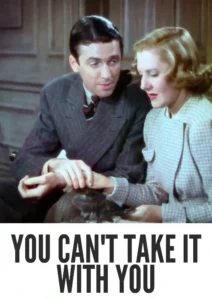Contact: [email protected]
Video Sources 0 Views
- Watch trailer
- You Can't Take It with You


Synopsis
Table of Contents
ToggleReview: You Can’t Take It with You (1938) – A Heartwarming Comedy Classic in Living Color

Introduction
“You Can’t Take It with You” (1938) is a heartwarming comedy that continues to charm audiences with its timeless humor and endearing characters. In this article, we’ll explore the significance of this early colored film and its enduring appeal in the realm of classic cinema.
Check The Full Colorized Movies List
Check Our Colorized Movies Trailer Channel
Understanding You Can’t Take It with You: Director, Cast, and Genre
Directed by the legendary Frank Capra, “You Can’t Take It with You” (1938) showcases his knack for blending humor with heart, creating a film that resonates with audiences of all ages. The movie boasts a stellar ensemble cast, including James Stewart, Jean Arthur, and Lionel Barrymore, whose performances bring the eccentric Sycamore family to life with warmth and charm. Blending elements of comedy, romance, and social commentary, “You Can’t Take It with You” (1938) is a testament to the power of love and laughter in the face of adversity.
Exploring the World of You Can’t Take It with You: Plot and Characters
At its core, “You Can’t Take It with You” (1938) tells the story of the free-spirited Sycamore family, whose unconventional lifestyle clashes with the rigid norms of society. When their daughter falls in love with the son of a wealthy businessman, chaos ensues as the two families are forced to confront their differences and learn to accept each other for who they are. Along the way, we meet a colorful cast of characters, from fireworks enthusiasts to ballet dancers, each adding their own unique flavor to the Sycamores’ zany world.
The Art of Film Colorization
Film colorization has the power to breathe new life into classic movies, allowing audiences to experience familiar stories in a fresh and vibrant way. By digitally adding color to black and white films, colorization opens up new possibilities for appreciation and interpretation, inviting viewers to explore the rich visual tapestry of cinematic worlds with renewed enthusiasm and wonder.
Early Colored Films: A Brief History
The history of colored films stretches back to the early days of cinema, with filmmakers experimenting with various techniques to add color to their creations. From hand-painted frames to early Technicolor processes, the evolution of colored film has been marked by innovation and creativity, paving the way for the development of modern colorization techniques that continue to captivate audiences to this day.
You Can’t Take It with You and Its Early Colored Version
The decision to release “You Can’t Take It with You” (1938) in a colorized format was met with both excitement and skepticism. While some welcomed the opportunity to experience the film in vibrant color, others expressed concerns about the potential impact on its visual aesthetic. Nevertheless, the early colored version of “You Can’t Take It with You” (1938) offers viewers a fresh perspective on the timeless themes of love, family, and acceptance, enhancing its emotional resonance and inviting audiences to rediscover the magic of Capra’s classic comedy.
The Debate Over Film Colorization
The debate over film colorization continues to divide audiences and critics alike, with proponents arguing that it revitalizes classic movies for modern audiences, while detractors maintain that it compromises the artistic integrity of the original work. As the debate rages on, filmmakers and audiences alike are left to ponder the merits and drawbacks of colorization in the ever-evolving landscape of cinema.
Examining You Can’t Take It with You as an Early Colored Film
As with any colorized classic, the impact of colorization on “You Can’t Take It with You” (1938) is a matter of personal interpretation. Some may argue that it enhances the film’s visual appeal and immerses viewers in its world, while others may feel that it detracts from the stark beauty of the original black and white version. Regardless of one’s stance on the issue, there’s no denying the enduring power of “You Can’t Take It with You” (1938) as a timeless comedy classic that continues to delight audiences with its wit, charm, and warmth.
Influence and Legacy: You Can’t Take It with You’s Impact on Cinema
“You Can’t Take It with You” (1938) has left an indelible mark on the world of cinema, inspiring countless filmmakers and captivating audiences with its timeless humor and heartfelt storytelling. From its unforgettable performances to its poignant message of love and acceptance, the film continues to resonate with viewers of all ages, reaffirming its status as a beloved classic of the comedy genre.
Director’s Cinematic Legacy: Beyond You Can’t Take It with You
Frank Capra’s influence extends far beyond “You Can’t Take It with You” (1938), with a diverse body of work that continues to captivate audiences around the globe. From “It’s a Wonderful Life” to “Mr. Smith Goes to Washington,” Capra’s films are celebrated for their optimism, humanity, and unwavering belief in the goodness of the human spirit. Through his groundbreaking work, Capra has left an indelible imprint on the world of cinema, inspiring generations of filmmakers to follow in his footsteps.
Themes Explored in You Can’t Take It with You
“You Can’t Take It with You” (1938) explores a myriad of themes, from the pursuit of happiness to the importance of family and community. Through its richly drawn characters and witty dialogue, the film invites viewers to ponder the complexities of human nature and the universal desire for love, laughter, and belonging. As audiences immerse themselves in the world of the Sycamore family, they are reminded of the timeless truths that unite us all and the enduring power of laughter to heal and uplift the soul.
Reception and Controversy Surrounding You Can’t Take It with You
Upon its release, “You Can’t Take It with You” (1938) received widespread critical acclaim, with many praising its clever script, charming performances, and heartfelt message. However, the decision to release the film in a colorized format sparked debate among purists, reigniting the age-old discussion surrounding film preservation and artistic integrity. Despite the controversy, “You Can’t Take It with You” (1938) remains a beloved classic that continues to entertain audiences of all ages, reaffirming its status as a timeless masterpiece of the comedy genre.
Where to Watch You Can’t Take It with You Online
For those eager to experience the timeless magic of “You Can’t Take It with You” (1938), the film is readily available on popular streaming platforms such as Netflix, Amazon Prime, and Hulu. Whether you choose to watch it in its original black and white format or the early colored version, “You Can’t Take It with You” (1938) promises to delight and inspire with its wit, warmth, and irrepressible spirit.
FAQs About You Can’t Take It with You
Q: Is “You Can’t Take It with You” (1938) based on a true story? A: No, “You Can’t Take It with You” (1938) is a fictional comedy that follows the antics of the eccentric Sycamore family as they navigate the ups and downs of life and love in Depression-era America.
Q: Who are the main actors in “You Can’t Take It with You” (1938)? A: “You Can’t Take It with You” (1938) features an ensemble cast led by James Stewart, Jean Arthur, and Lionel Barrymore, whose performances bring the quirky Sycamore family to life with warmth and humor.
Q: What awards did “You Can’t Take It with You” (1938) win? A: “You Can’t Take It with You” (1938) won two Academy Awards, including Best Picture and Best Director for Frank Capra, cementing its status as a beloved classic of the comedy genre.
Q: Why was “You Can’t Take It with You” (1938) released in a colorized format? A: The decision to release “You Can’t Take It with You” (1938) in color was made to introduce the film to a new generation of viewers and enhance its visual appeal for modern audiences. While the choice to colorize the film sparked debate among purists, it ultimately allowed “You Can’t Take It with You” (1938) to reach a wider audience and ensure its continued relevance in the annals of cinematic history.
Conclusion
“You Can’t Take It with You” (1938) remains a timeless classic that continues to captivate audiences with its wit, warmth, and irrepressible spirit. Whether viewed in its original black and white format or the early colored version, the film reminds us of the enduring power of love, laughter, and acceptance in the face of adversity. So, grab a bowl of popcorn, gather your loved ones, and settle in for a night of timeless entertainment with “You Can’t Take It with You” (1938).




















